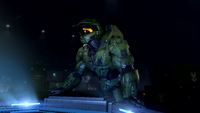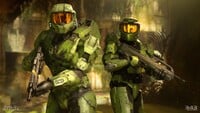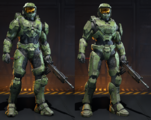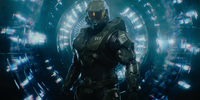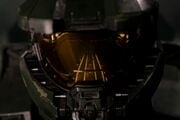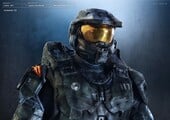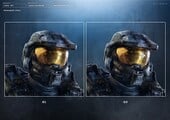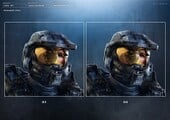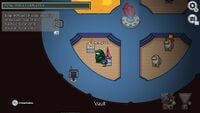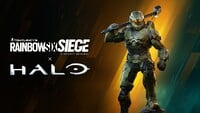MJOLNIR Powered Assault Armor/Mark VI
From Halopedia, the Halo wiki
| MJOLNIR Powered Assault Armor | |
|---|---|
| Production overview | |
|
Manufacturer(s): |
|
|
Testing site(s): |
|
|
Type: |
|
|
Role(s): |
General combat |
| Technical specifications | |
|
Feature(s): |
Energy shielding |
- "Once he gets a hold of this armor, I think we'll all start sleeping a little better at night."
- — Maria-062[2]
The MJOLNIR Powered Assault Armor/Mark VI was the third major version of the MJOLNIR Powered Assault Armor. The last mainline MJOLNIR GEN1 suit to be widely issued,[3] the Mark VI was issued to the few surviving Spartan-II supersoldiers in October 2552, replacing the Mark V. Shortly after the end of the Human-Covenant War, it was replaced by the Mark VII[4] and MJOLNIR [GEN2]. The Mark VI could still be requisitioned by Spartan-IV personnel as late as October 2558, albeit upgraded to function with the GEN2 suite.[3][5] In early 2559, in the midst of the Created conflict, the Mark VI armor has been upgraded to the GEN3 platform.[6][7]
Overview[edit]
Late into the war, as work on the MJOLNIR Mark V was being completed, a top-secret parallel development lab in Songnam, Korea, began work on their own prototype of Project: MJOLNIR. This project came to be known as MJOLNIR: BLACK, a standalone "skunkworks" prototype of the Mark VI MJOLNIR armor.[8] Using data from the existing and in-development versions of the MJOLNIR armor, the Seongnam team was able to produce a suit with many technical advancements not yet available to the standard Mjolnir system. After extensive testing of prototype models in combat against the Covenant, the BLACK prototype was eventually inducted into the Mjolnir line and officially designated as the sixth version.[9] It was approved for use after the loss of Reach and equipped to the surviving Spartan-IIs after their arrival on Earth.
The Mark VI is capable of taking full advantage of the physical capabilities of a Spartan. The suit is constructed in overlapping layers. It is environmentally sealed, capable of extra-vehicular activity and operations in toxic atmosphere. It is hardened against electromagnetic pulses and radiation, and has filters that are effective at removing toxins and bacteria from the local atmosphere.[10]
The armor's shell is composed of a multilayer alloy of remarkable strength and has been augmented with a refractive coating capable of dispersing a limited number of impacts from Covenant energy weapons. The suit contains a gel-filled layer underneath a thick black armored bodysuit. The gel layer regulates temperature and can reactively change its density. The inner skinsuit is made of a moisture-absorbing synthetic material linked to an environment control computer and the occupant's neural interface.
Spartans are implanted with a unique model of the command neural interface. This network translates electrochemical signals to digital code and routes them through an interface connection at the rear of the skull. Through this interface, the user's thoughts command the armor's movement and use of weapons, and input from the onboard sensors comes directly to the user's mind. The synthesis of machine and mind is so fast that it is almost impossible to chart reaction time.
Each suit of Mjolnir Mark VI armor contains a layer of superconducting computer memory. Envisioned by Dr. Catherine Halsey, this revolutionary layer forms a network, capable of supporting the kinds of artificial intelligence usually reserved for starships, a piggyback system.
The suits also contain a strength-enhancing layer. This marvel of engineering uses piezoelectric properties to enhance and assist a Spartan's already prodigious muscle power, and grant superhuman feats of might.
The Mark VI largely solves problems with the previous versions of Mjolnir armor. It has an improved energy shielding system, powered by a smaller fusion pack on the wearer's back. This shield system is much stronger and charges more quickly than the Mark V's. The suit also has denser yet less bulky armor plating. These streamlined plates have fewer grapple points than the Mark V so that an enemy has fewer advantages in close combat.[11]
In addition, the Mark VI's liquid crystal and hydrostatic gel layers received significant improvements over the previous version. The liquid crystal layer increases the strength of the wearer by a factor of five in addition to amplifying the user's reaction time by the same factor.[12] The hydrostatic layer features a lock-down device, which protects the muscles and joints of its Spartan wearer from heavy-impact injuries.[13]
In addition to major component upgrades the Mark VI introduce a number of smaller technical improvements to components, these included recoil-compensating actuators which handle weapon feedback, as a Spartan is firing a weapon in combat these actuators handle a weapons recoil reducing it without affecting the performance of the Spartan user. The Mark VI also possesses an improved computer system which continuously monitors weapons, biological functions, and motion through an intelligent motion tracker.
The third stage in the MJOLNIR evolution, the Mjolnir Mark VI is a fully neural-linked system. With an onboard artificial intelligence using the human mind for parallel processing, the SPARTAN-II/MJOLNIR combination was the most devastating intelligence tool ever created.
Variants and compatibility[edit]
GEN1[edit]
Prototypes[edit]
- MJOLNIR: Black
A "skunkworks" prototype of the MJOLNIR Powered Assault Armor, likely part of MJOLNIR's Advanced Hardware Program. It was designed by a top-secret parallel development lab in Songnam, Korea. Spartan II Black Team was equipped with MJOLNIR: Black from at least the summer of 2552.
- Mark VI helmet
In 2552, prior to the Fall of Reach, some Mark VI helmets were tested on the Mark V[B] armor. Surviving helmets were later upgraded to be roughly equivalent to GEN3 by 2560.[14]
Variants[edit]
Being a modular armor system, Mjolnir can fulfill multiple combat roles and operate in various environments. A number of variants have been designed for to meet the mission requirements and situations. These variants are the pinnacle of Mjolnir evolution from design and function gathered from data, feedback, incidents and general design improvements gather throughout the Human-Covenant War.
- MJOLNIR/A - Rogue - One of several armor sets made by private companies, a trend that would become standard with GEN2.
- MJOLNIR/Argus - Argus - Variant with an increase in situational and threat awareness.
- MJOLNIR/C - CQB - Designed specifically for close combat by making joints more mobile and including additional attachments for additional close quarters equipment.
- MJOLNIR/Centurion - Centurion - Variant designed to test new technology.
- MJOLNIR/EOD - EOD - A variant designed for explosive ordnance disposal.
- MJOLNIR/Hoplite - Hoplite - Features targeting and datalink advancements to improve the accuracy and lethality of Spartans utilizing long-range heavy munitions such as the M41 rocket launcher.
- MJOLNIR/M - Security - Privately manufactured variant designed for security personnel.
- MJOLNIR/MIRAGE - Mirage - Variant of the Semi-Powered Infiltration armor, modified to be compatible with the MJOLNIR systems.
- MJOLNIR/ODST - The Mark V is compatible with several parts of the ODST armor, including the helmet, chest-piece, and shoulder pauldrons.
- MJOLNIR/R - Recon - A variant specialized for reconnaissance missions, developed parallel to the S variant.
- MJOLNIR/S - Scout - A variant with limited stealth capabilities, developed parallel to the R variant.
- MJOLNIR/V - EVA - Variant that specialized to improve survivability of Spartans when performing extra-vehicular activity in vacuum.
Mark VI MOD[edit]
- Main article: Mark VI MOD
Referred to as Mark VI MOD,[15] the Mark VI Mjolnir armor worn by MCPO John-117 following the end of the Human-Covenant War was updated by UNSC AI Cortana during his four years and seven months of cryosleep aboard the UNSC Forward Unto Dawn. Cortana used minifacturing and diagnostic systems to repair and alter John's armor. This armor closely resembles an earlier line of Mark IV armor.[16][17][18] She also rewrote the suit's firmware, altering the HUD as well as improving the suit's shield recharge rate and its compatibility with Covenant and Forerunner armor plugins.[19] This armor was damaged during the Mission to Installation 03 and replaced by a similar GEN2 Mjolnir armor variant.[20]
[edit]
Some Mark VI variants are superficially similar to the GEN2 Mjolnir armor introduced in the wake of the Human-Covenant War.[21] By October 20, 2552, Frederic-104 and Linda-058 had been issued prototype Centurion and Argus variants, respectively. Both of these armors have a bodysuit similar to that of the GEN2 armor and they would stay superficially unchanged with the transition to the GEN2 platform.[22] Fred and Linda received upgraded GEN2 versions of their suits in the post-war era, while Kelly-087 donned the GEN2 Hermes variant at some point after being rescued from the shield world Trevelyan.
Mark VI GEN2 testing variant[edit]
This Mark VI looks similar to the hybrid GEN2/Mark VI [GEN1] armor, although it uses a slightly different techsuit from the mainline GEN2 armor.[23]
GEN2[edit]
Variants[edit]
Following the development of the GEN2 Mjolnir in the wake of the Human-Covenant War, the external components of the original Mark VI armor were reproduced as a variant of the new generation. This Mark VI incorporates slight modifications to accommodate the different base architecture of the GEN2 system.[3][5]
- Hybrid GEN2/Mark VI [Gen 1]
This variant of Mark VI uses many components from the base Mark VI as they have proven to be functional even after taking significant damage.[24]
- GEN2 Mark VI
This variant of Mark VI keeps all the designs of the original Mark VI armor, but has been completely updated to modern powered assault armor standards. This variant has a classic GEN1 heads-up display, a solid collar frame and branch locking system. It is also equipped with a Class-3B Essen shield distributor. The Ordnance Commission allowed this variant to be used due to the original Mark VI's performance.[1]
- GEN2 Mark VI MOD
Following the Mission to Installation 03, John-117 upgraded to the GEN2 platform.[20][25] This suit is still designated Mark VI MOD.[26] The upgrade was made by ONI's Watershed Division.[27]
GEN3[edit]
- "Hey Chief is that Mark VI armor? GEN3? Both? Neither? Does it have nanomachines?"
- — A Marine during the Battle for Zeta Halo.[28]
On February 10, 2559, the Materials Group manufactured a complete set of GEN3 Mark VI armor for John-117.[6][15][29] By October 7, this armor was also worn by Frederic-104, Kelly-087 and Linda-058. It looks aesthetically similar to a MJOLNIR [GEN1] Mark IV armor variant they used during Operation: WARM BLANKET. By 2560, the GEN1 Mark VI shoulders and the GEN2 Mark VI MOD shoulders were both made by the Materials Group to be compatible with the GEN3 Mjolnir platform.[30]
HAZMAT[edit]
- Main article: Mark VI CBRN
A CBRN variant of the Mark VI helmet was developed by the Materials Group and used throughout the testing and evaluation of the OSTEO combat engineering suit.[31]
Armor components[edit]
- Inner skinsuit: The inner skinsuit is made of a moisture-absorbing synthetic material linked to an environmental control computer and the occupant's neural interface. It controls the suit's temperature and actively changes how the suit fits the user.[32]
- Integrated communications helmet:[33][34] The ICH is one of the most vital aspects of the MJOLNIR system. It is made of Titanium, contains key features like a Heads Up Display, and can identify equipment and display information about it when it is picked up by the wearer. Another feature is the direct neural interface system, which connects to a Spartan's neural implants. Two core processor chips are implanted into the subject's skull at the rear of the head. This is essentially comparable to an on board computer using parts of the human brain for processing - when the connector at the rear of the subject's head and receptors in the brain link to the helmet's on board sensors it creates the neural link needed to move the MJOLNIR suit. The helmet also contains equipment to protect the user in hostile conditions, such as filters to remove toxins from the atmosphere, an oxygen supply to provide air to the wearer during EVA, thermal and motion trackers, radio communicators, solar-powered lighting, and imaging and video gear. The helmet also contains an AI housing located on the back of the helmet.
- Titanium alloy outer shell: The outer shell of the Mjolnir armor is comprised of a fairly thick titanium alloy. This plating covers the chest, arms, hip, legs, calves, feet and hands. This alloy is very resilient, can take significant damage, and is nearly impervious to small arms fire. While enough shots from armor piercing rounds will breach the outer shell, the suit can take a few glancing blows from them without compromising the armor. The outer shell of the all Mjolnir suits is covered with a refractive coating to help disperse the heat experienced from Covenant energy weapons. However one or two direct hits from any Plasma weapon will compromise the armor plating.
- Titanium nanocomposite bodysuit: Sandwiched between the external armor and the internal padding is a thick black armored bodysuit. This suit has numerous functions, small but vital to the safety and survival of the wearer. The bodysuit is made of a titanium-based material, making it very strong and yet very flexible. It also serves as another layer of protection against ballistics attacks and is coated with a heat resistant material to disperse heat from plasma weapons.
- Hydrostatic gel: Underneath the armored bodysuit is a gel-filled layer, this gel layer regulates the temperature of the suit and can re actively change its density to conform to the wearer's shape - the temperature inside the suit is controlled by the moisture absorbing cloth suit underneath the hydrostatic layer. The hydrostatic gel layer can also be pressurized to various levels to potentially save the wearer's life should the wearer be subjected to high G forces or a high velocity impact; however, over-pressurizing this layer can cause nitrogen embolisms.[35][36]
- Reactive metal liquid crystal layer: Sandwiched between the external armor and the internal padding is a layer of piezoelectric material that deforms along a preferred axis when exposed to an electric charge. This layer acts as synthetic muscle, allowing the Spartan access to approximately five times their unarmored strength when using the Mark VI due to new optimization of the crystalline geometries.[1][13]
- Memory-processor superconductor layer: A layer relatively new to the Mjolnir line, introduced with the Mark V, that is capable of housing an AI. Comprised of the same material as a starship's AI system, this layer allows an AI to travel with a soldier into the field. The AI can then aid the soldier in software intrusion, hardware hacking, and espionage by listening to enemy chatter.[37]
- Magnetic weapon holder strips: Powerful magnets are placed on the legs, waist, and back of the suit to hold any equipment with a magnetic property. The suit also contains a magnet system on the boots of the MJOLNIR suit that allow its wearer to stay attached to a metal surface in Zero G environments and can be toggled on or off by the wearer.
- Energy shields: First tested with the Mark IV, made standard with the Mark V, and later refined with the Mark VI, the energy shield device is reversed engineered from Covenant technology. Beginning prior to 2531, forty scientists and technicians would spend the next two decades attempting to make some use of the technology. For decades the attempts at cracking their technology had met with failure after failure, some had given up and others in the scientific community believed the energy shield technology could never be cracked. However at some point before 2552 a breakthrough was made and for the first time the UNSC had successfully cracked and improved upon the technology.[38]
- Pressure seal: The pressure seal is a vital component to the MJOLNIR system, it keeps the system airtight, underwater or in space. The seal is very strong and will only break under extreme pressure, such as in a high velocity impact or when the hydrostatic gel has been over pressurized.
- Automatic biofoam injectors: Biofoam injectors are an integral part of the systems that keep a SPARTAN-II functioning in battle. Biofoam is a medical gel that is used to fill and seal a wound automatically, it is also used to treat any infection that could occur as a result of the wound.
- Fusion reactor: The fusion reactor is the most essential part of the Mjolnir system, as it provides power to all equipment on the armor - the reactor is built into the suit and allows for nearly unlimited movement. The fusion reactor in all versions of the Mjolnir armor are half the size of a normal battery pack used by Marines.[39]
- Force-multiplying circuits: Located throughout the armor, these systems boost the force applied by the user. They make hand-to-hand combat easier, but also make the armor difficult to adjust to; a slight motion can be translated into a potentially harmful one if not conducted correctly. For this reason it is only possible for Spartans to use this armor, as their strengthened bodies are able to withstand the increased power and speed of movement, which, in un-augmented human bodies, results in broken bones or death, due to spasms caused by the pain of broken bones.
- Reactive circuits: Reactive Circuits are systems installed directly linked to the Spartan neural interface. They amplify the wearer's reaction time by connecting directly to the thoughts of the wearer, making it much easier to control and allowing for the soldier to be both more efficient and have a higher survival rate in combat.
- Power supply control unit: Manages the power supply of the armor.
- MJOLNIR Mark VI BIOS: The basic input/output system, standard firmware interface for the Mark VI.
- Lock-down system: The lock-down system protects muscles and joints from traumatic, high-impact injuries by seizing the suit into a rigid posture through modifying the density of the hydrostatic gel layer.[13][40][41][42]
- Quantum mirror: A part of the armor's motion sensor system, located in the shoulder pauldron.[43]
- Fail-safe detonation system: This system functions as a self-destruct mechanism in order to prevent a dead Spartan's armor from being compromised by hostiles. It is activated by a series of digits that only the Spartans know. When engaged, it produces a reactor overload that burns everything within a ten-meter radius, then produces a large blast.[44]
- Auto-repair and bypass nodes: Any damage that the titanium armor plating suffers can be repaired by built-in, triply-redundant subsystems. These systems are receptive to nanomachines facilitating the repair.[16] Additionally, bypass channels allow certain components to function if routing is compromised by extensive damage. Both these systems can fail, resulting in "scarred" armor plating.[45]
- Thruster pack: Located at the back of the armor, this component provides the ability to propel the wearer over short distances and to maneuver in low-gravity environments.[46]
- Holographic emitters: Unique to the GEN3 model of the armor, it has the ability to display the avatar of an AI that is traveling in the armor over the palm of the hand.[28]
Performance and durability[edit]
The Mark VI armor was the culmination of decades of research and re-engineering its predecessors, Mark IV and Mark V. This armor was not only more condensed than its previous iterations, but it was also much more durable.
While stranded on Line Installation 1-4, a Mark VI prototype worn by a member of Black Team was able to withstand being punched into a Forerunner terminal by a Mgalekgolo and keep its wearer completely intact in the process.[47]
After boarding the Forerunner Dreadnought, John-117's Mark VI Mjolnir withstood impacting the Earth's surface from mid-atmosphere.[48]
During the Onyx Conflict, Frederic-104's Mark VI Mjolnir was able to withstand a direct hit from a Mgalekgolo's assault cannon and not suffer any major damage.[49]
Onboard the bow of the UNSC Forward Unto Dawn's bisected wreckage, John launched a Hyperion nuclear missile into the hull of an unshielded Zanar-pattern light cruiser in response to the Covenant remnants attack on the Dawn. With his MJOLNIR's strength-multiplying circuits, John was strong enough to re-activate the hammer's seized sliding apparatus by overwhelming the jam's heavy traction simply by shoving and then kicking it into place.[50]
Subsequent to the Ur-Didact's awakening, and during the destruction of Requiem's core, John's MJOLNIR-donned frame was cratered several meters deep into non-porous, rocky terrain. The armor proved strong enough to resist the blunt-force trauma of such an impact with no visible damage - at the minor expense of an interim concussion.[51]
During the Battle over Installation 07, John's GEN3 armor took several heavy hits from Atriox, enough to stun the Spartan, but it kept functioning. After being thrown into space, the armor shut down, but it went into survival mode which was able to keep the Spartan alive for six months in the vacuum of space with no food, water, or other things vital to life aside from the suit's oxygen supply. When John was recovered, Fernando Esparza's scan of the suit suggested that its main power cells were fried, yet once it was brought out of survival mode, the armor's fusion reactor almost instantly recharged the Pelican's depleted batteries and it resumed full functioning once again.[52] The Master Chief later told the Weapon that the next thing that he remembered after getting thrown into space was waking up on the Pelican six months later, suggesting that he had been kept unconscious by the armor for the entire time.[53] This may suggest that the armor contains high-calorie nutrient supplements to keep its occupant alive, similar to the GEN3 Mark VII armor.[54]
 This section needs expansion. You can help Halopedia by expanding it.
This section needs expansion. You can help Halopedia by expanding it.
In-game information[edit]
Halo 3 - GEN1[edit]
The Mark VI armor permutation is one of the default unlocked armor sets available in Halo 3.
Halo: Reach - Mark VI prototype[edit]
- "This is the prototype for the Integrated Communications Helmet, MJOLNIR Mk. VI."
The Mark VI helmet is available as armor permutations in Halo: Reach. The helmet is first able to be viewed at the rank of Captain, and is purchasable at Brigadier.
| Armor | Description | Unlock requirements (Halo: Reach) | Unlock requirements (Halo: MCC) |
|---|---|---|---|
Mark VI |
Data gathered from these field tests will be used to improve the final production model. | Series 1, Tier 86 ( | |
Mark VI (FC-I[2]) |
External command network and hardened 3rd-generation uplink modules. | Series 1, Tier 90 ( | |
Mark VI (UA/HUL-I) |
Up-armored variant with hardened 3rd-generation uplink module for MILINT acquisition. | Series 1, Tier 91 ( |
Halo 4 - GEN2[edit]
Mark VI was one of the armor permutations to return, slightly redesigned for GEN2, in Halo 4.
| Armor | Description | Unlock requirements (Halo 4) |
Unlock requirements (Halo: MCC) |
|---|---|---|---|
 Mark VI |
Description (H4): Last series of mainline Mjolnir GEN1 armor types worn by SPARTAN-II personnel. | Obtained by completing the Halo 4 campaign on Legendary. | Unlocked by default. |
| Helmet description (MCC): Last of the GEN1 helmets in general use by Spartan-IVs. | |||
| Shoulders description (MCC): Modular left/right spaulder from Mark VI-class armor. | |||
| Chest description (MCC): Modified for GEN2 compatibility. | |||
| Forearm description (H4): Classic GEN1 system for Mjolnir Mark VI, most notably worn by S-II personnel in 2552. | |||
| Forearm description (MCC): Mark VI vambrace worn by SPARTAN-II personnel. | |||
| Legs description (H4): Standard GEN1 greave system for Mjolnir Mark VI, leveraged primarily by S-II personnel. | |||
| Legs description (MCC): Based on proven designs. |
Halo 2: Anniversary - GEN1[edit]
The Mark VI armor is a armor permutation for Spartan characters in Halo 2: Anniversary.
| Armor | Description | Unlock requirements |
|---|---|---|
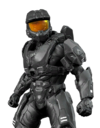 Mark VI |
Canon Fodder description: The Mk.VI Mjolnir technology platform was designed with modularity and iterative development in mind. | Unlocked by default. |
| MCC description: The Mark VI Mjolnir technology platform was designed with modularity and iterative development in mind. |
Halo 5: Guardians - Upgraded GEN1 and GEN2[edit]
The Halo 4 design of Mark VI returns in Halo 5: Guardians. The helmet and body armor are unlockable through the Requisition system.
| REQ Card | Description | Unlock requirements |
|---|---|---|
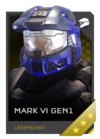 Mark VI GEN1 (helmet) |
Key features of the iconic Mark VI helmet design have been retained in all of its newer permutations. |
|
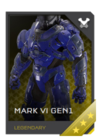 Mark VI GEN1 (body) |
Technically obsolete, the Mark VI[GEN1] Mjolnir armor maintains a legendary luster among Spartans and the general public. | |
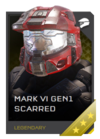 Mark VI GEN1 Scarred (helmet) |
Constructed with the utmost care and multiply redundant subsystems, MARK VI helmets can remain functional even after horrendous damage. |
|
 Mark VI GEN1 Scarred (body) |
The MARK VI was able to remain functional until all of its triply-redundant auto-repair and bypass nodes failed. | |
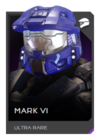 Mark VI (helmet) |
Key features of the iconic Mark VI helmet design have been retained in all of its newer permutations. |
Ultra Rare REQ card |
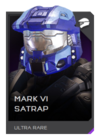 Mark VI Satrap (helmet) |
Ultra Rare REQ card | |
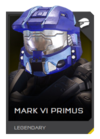 Mark VI Primus (helmet) |
Legendary REQ card | |
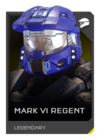 Mark VI Regent (helmet) |
Legendary REQ card | |
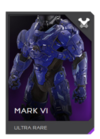 Mark VI (body) |
Without question the most famous of all Mjolnir permutations, the GEN2 MARK VI has been completely updated to modern powered assault armor standards. |
Ultra Rare REQ card |
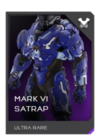 Mark VI Satrap (body) |
Ultra Rare REQ card | |
 Mark VI Primus (body) |
Legendary REQ card | |
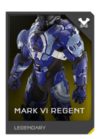 Mark VI Regent (body) |
Legendary REQ card |
Halo Infinite - Upgraded GEN1 and GEN3[edit]
In Halo Infinite the prototype Mark VI helmet from Halo: Reach and its attachments are available for multiplayer Spartan armor customization. It was originally exclusive to the Mark V [B] armor core before becoming cross-core in Season 05: Reckoning. Some new GEN1 Mark VI shoulders were made available under the UA category on the Mark VII armor core in Season 04: Infection. Season 05: Reckoning added the GEN3 Mark VI as an armor kit on the Mark VII core attainable once players reach the Hero rank.
| Armor | Manufacturer | Lore | Rarity | Unlock Requirements |
|---|---|---|---|---|
Mark VI |
Materials Group | Late-iteration prototypes of the MARK VI helmet were undergoing final testing just weeks before the Covenant assault on Reach. Unfortunately, much of the resulting combat data was not recoverable by the Seongnam-based development team. | Epic | Season 01: Heroes of Reach Battle Pass level 84 (Premium) |
  UA/Mark VI [GEN1] |
Materials Group | Sometimes the best solutions are the ones that stand the test of time. | Rare | Purchase the "Gulfshore" bundle in the Shop for 800 cR |
 Infinite Mark VI |
Materials Group | Master Chief Petty Officer John-117 is a living legend, Reclaimer of ancient legacies, and Demon to humanity's enemies. He is humanity's most sophisticated and effective piece of military hardware, accomplishing feats that have stymied entire armies of lesser warriors and fleets of ships. Though his stance and posture can be at ease, the Chief is always ready to launch into action at a moment’s notice. | Legendary | Reach the Hero career rank |
Attachments[edit]
- CNM/BNR/FARNDALE
- CNM/BNR/TYPHON
- HUL-I/XFTREC/FLAMINGO
- HUL(3)/BNR/COURIER PEARL
- TAC/RS/STARLIGHT
- UA/Type E3
Non-canon and dubious canon appearances[edit]
Silver Timeline[edit]
| This article contains information about the Silver Timeline, and is not a part of the established Halo canon. |
- "This is Mark VI MJOLNIR armor. The outer layer is enhanced titanium. You won't even dent it."
- — John-117 to Kwan Ha.[55]
By the time of Operation: DEFIANT GLASS in 2552, John-117 and the Spartans of Silver Team were all equipped with Mark VI armor. The suit is equipped with a heads-up display and energy shielding.[55] However, James Ackerson took the armor with him when he abandoned Reach to the Covenant, leaving Silver Team to fight in the Fall of Reach unarmored.[56]
Production notes[edit]
Halo 2 and Halo 3[edit]
John-117 wears a Mark VI suit throughout the campaigns of Halo 2 and Halo 3. The Mark VI armor experienced minor graphical changes between these two games, most notably in the design of the gauntlets. The colors are more muted, with the armor bearing a gray hue. The general shape of the HUD is the same. However the radar is slightly larger and the ammo and grenade counters are no longer enclosed in templates. The most obvious difference is that the shield meter has been relocated from above the radar to the top-center of the HUD. Additionally the radar has a radius reading, with a default 25 meters. These changes appear to be purely aesthetic in nature and have no canonical explanation, though the discoloration could be due to extended and rigorous use and the HUD changes could simply be updates.
Halo: Reach[edit]
The Mark VI helmet appears in Halo: Reach as a prototype, possibly MJOLNIR: Black variant.[34] Two upgrades are available for the helmet, the first of which adds a Command Network Module on the left side with a Hardened Uplink Module-3rd Generation on the right side (FC-I[2]). The second upgrade adds an up-armor plate with a Command Network Module-Improved on the right side. The top part of the helmet has a single white stripe painted down the middle. Additionally, the sun visor is colored solid black.[34]
Halo 4 and Halo 5: Guardians[edit]
Campaign[edit]
John-117 continues to wear his original Mark VI suit in Halo 4's campaign, although it has been redesigned.[57] In an interview with Game Informer, Frank O'Connor offhandedly mentioned that Cortana used nanomachines to repair the suit;[16] In Halo 4, the suit still has the gash it has featured since Halo 3 as it was not repaired,[57] apparently because that area suffered irreparable damage.[45] Halo 4: The Essential Visual Guide notes that Cortana fully updated the suit, and that it resembles an earlier line of the Mark IV.
John's armor in Halo 5: Guardians is largely identical to its appearance in Halo 4, barring minor cosmetic updates. The faceplate has been changed from a dull shade of orange to the vibrant gold of earlier titles. The formerly gashed chestplate is now intact. The undersuit's snakeskin texture is now limited to the arms and upper torso; the rest of the undersuit is smooth, with the waist and legs sporting a subtle digital camouflage pattern. Red piping is painted around the fusion pack's vents, although in the final release of the game, the red piping on the undersuit is now an olive green color, the same as the undersuit's main color.
Multiplayer[edit]
The original Mark VI helmet, chest, shoulder, arm, and leg armor are available in the Infinity mode after completion of Halo 4's campaign on Legendary difficulty. Though the helmet is mostly unchanged from its Halo 3 incarnation, the rest of the suit has received several minor aesthetic updates.[3][58] Canonically, this version of the Mark VI is available for issue to Spartan-IVs, having been updated for use with GEN2.
The GEN1 and GEN2 Mark VI are also available in Halo 5: Guardians multiplayer. The GEN1 Mark VI is identical to the Halo 4 version apart from the restoration of the armor protecting the groin.[25]
Trivia[edit]
- In Halo: Reach the letters "FH" appear near the chin area of the Mark VI that is also present on the hood of the Warthog.[59]
- The armor worn by Operation Firepower from Marvel Comics' Ultimate universe greatly resembles the Mark VI, combined with elements of Iron Man's armor. The helmet is nearly identical to that of the Mark VI and likewise has an orange face plate, though it features the distinctive eye slits of Iron Man's armor.
- In Halo 4, the back-right of the Mark VI armor has an emblem comprising a star with two chevrons underneath. This symbol appears to be based on the insignia of the UNSC's Seventh Fleet, (sans one chevron), as seen on the hulls of the UNSC Forward Unto Dawn and UNSC Aegis Fate in Halo 3.
Gallery[edit]

|
Browse more images in this article's gallery page. |
Halo 2 and Halo 2: Anniversary campaign[edit]
The Halo 2 Mark VI armor rendered in Unreal Engine 4 in Halo: The Master Chief Collection.
Linda-058 and Fred-104 clad in Mjolnir Mark VI variants before the Battle of Earth in Halo 2: Anniversary's terminals.
Halo 3[edit]
Spartans wearing Mark VI in the Halo 3 Beta.
Halo: Reach[edit]
Halo 4, Halo 2: Anniversary multiplayer, and Halo 5: Guardians[edit]
The Scarred version of the GEN1 Mark VI armor in the Halo 5: Guardians Multiplayer Beta.
Halo 5: Guardians skins[edit]
Halo Infinite[edit]
Concept art[edit]
Concept art of GEN3 Mark VI for Halo Infinite
Screenshots[edit]
Mark VI MOD being used in an early build of the Halo Infinite announcement trailer.
John-117 hanging in his GEN3 Mark VI in Discover Hope.
John-117's GEN3 Mark VI in the Halo Infinite Campaign Gameplay Premiere.
A Spartan-IV wearing a prototype Mark VI helmet on the Mark V(B) core.
Graffiti of GEN1 Mark VI on Bazaar.
A GEN3 Mark VI-clad Spartan-IV with a MA40 assault rifle.
A GEN3 Mark VI-clad Spartan-IV with a GEN1 Mark V-clad Spartan-IV on Forbidden.
Halo: The Television Series[edit]
John-117's Mark VI in the Halo: The Television Series Season One opening.
John-117 in his Mark VI Mjolnir on Eridanus II.
Concept art of John-117's Mark VI getting damaged for Halo: The Television Series Season Two.
Miscellaneous[edit]
Nicole-458 wearing Mark VI in Dead or Alive 4.
The wax figure of John-117 in Mjolnir Mark VI armor at Madame Tussauds.
John-117 in his GEN1 Mark VI on Installation 05 in Halo Mythos.
A statue of John-117 in his GEN1 Mark VI at Halo: Outpost Discovery.
List of appearances[edit]
Sources[edit]
- ^ a b c d Halo: The Essential Visual Guide, page 157
- ^ Halo Graphic Novel - "Armor Testing", page 68
- ^ a b c d Halo 4
- ^ Halo: Glasslands, page 213
- ^ a b Halo 5: Guardians
- ^ a b Discover Hope
- ^ Step Inside
- ^ Halo Evolutions Blunt Instruments page 195
- ^ Halo Encyclopedia (2009 edition) page 89
- ^ Halo Encyclopedia: The Definitive Guide to the Halo Universe page 92
- ^ Halo Encyclopedia: The Definitive Guide to the Halo Universe page 90
- ^ Halo Encyclopedia (2009 edition), page??
- ^ a b c Halo Encyclopedia: The Definitive Guide to the Halo Universe page 91
- ^ Halo Waypoint, Canon Fodder - Parallel Threads (Retrieved on Jun 25, 2021) [archive]
- ^ a b MegaConstrux Master Chief Collection
- ^ a b c YouTube - The Science Behind The Halo Series
- ^ Halo 4: The Essential Visual Guide, page 10
- ^ Halo Canon - Interview
- ^ Halo 4, campaign level Dawn
- ^ a b Jeff Easterling's Twitter - GEN2; in Escalation
- ^ Halo Waypoint - Frederic-104
- ^ Halo 2: Anniversary - Terminals, Terminals
- ^ Instagram - hmcc_spartans
- ^ Halo 5: Guardians - Armory description
- ^ a b Halo Waypoint: Canon Fodder - Conventional Warfare
- ^ Halo 5: Guardians Limited Edition, Spartan Locke's classified orders
- ^ https://mobile.twitter.com/GrimBrotherOne/status/791063783280025601
- ^ a b Halo Infinite, Marine dialogue
- ^ Halo Waypoint - Canon Fodder: Despite Distance
- ^ Halo Infinite, Armor Hall: UA/Mark VI [GEN1] - Shoulders Description "Sometimes the best solutions are the ones that stand the test of time."
- ^ Halo Infinite, Armor Hall: Mark VI CBRN - Helmet Description "Refitted Mark VI helmets were used throughout the testing and evaluation of OSTEO."
- ^ Halo: The Fall of Reach, page 71, (2001 edition) page 81, (definitive edition) page 90 (2010 edition)
- ^ Halo 3 - Mjolnir Mark VI helmet description
- ^ a b c Halo: Reach, Armory description
- ^ Halo: First Strike Page 13
- ^ Halo: Ghosts of Onyx Chapter 1, page 36
- ^ Halo: The Fall of Reach, Page 286
- ^ Halo: The Fall of Reach Chapter 27, page 249
- ^ Halo: The Fall of Reach Chapter 13, page 114; chapter 27, page 248
- ^ Halo 3, level Arrival
- ^ Halo: Reach, level Tip of the Spear
- ^ Halo Reach Legendary Edition developer commentary, part 4
- ^ Halo: Ghosts of Onyx, page 221
- ^ Halo: First Strike, page 315
- ^ a b Halo 5: Guardians Multiplayer Beta - Scarred Mjolnir Mark VI description
- ^ Halo 4, campaign level "Shutdown"
- ^ Halo: Blood Line: Issue 5
- ^ Halo 3, campaign level Arrival
- ^ Halo: Ghosts of Onyx, page 307
- ^ Halo 4, campaign level Dawn
- ^ Halo 4, campaign level Forerunner
- ^ Halo Infinite, campaign mission Ringfall: Warship Gbraakon
- ^ Halo Infinite, campaign mission Reformation: The Sequence
- ^ Halo: The Rubicon Protocol, chapter 22
- ^ a b Halo: The Television Series, episode Contact
- ^ Halo: The Television Series, episode Reach
- ^ a b Halo 4: Official Game Guide (Collector's Edition), page 441 (Prima - "Do you ever show damage on Chief's armor that speaks to the previous games or the rest of the fiction?" - Kenneth Scott: "Yes. The damage you see on his armor at the end of Halo 3 is still mostly there."
- ^ Halo Waypoint - The Halo Bulletin 09.05.12
- ^ FH Easter egg
| ||||||||||||||||||||||||||||||||||||||||||||||||||||||||||||||||||||||||||||||||||||||||||||||||||||
| ||||||||||||||||||||||||||||||||||||||||||||||||||||||||||||||||||||||||||
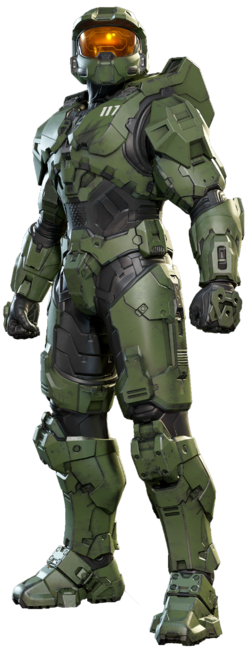
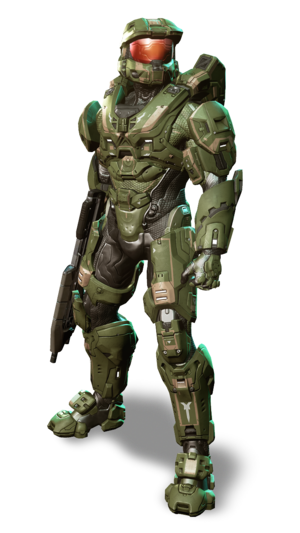




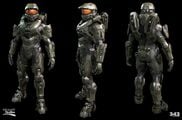








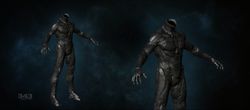
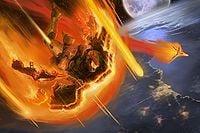
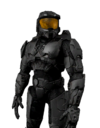
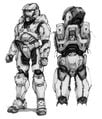



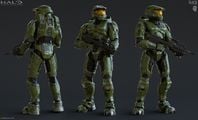





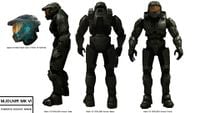



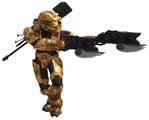

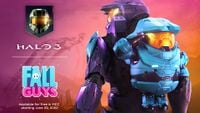
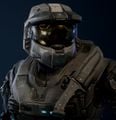
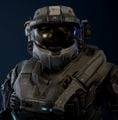
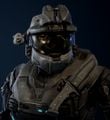

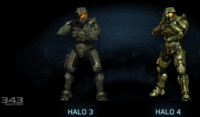
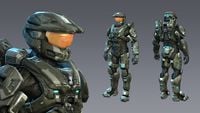

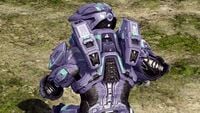
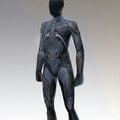




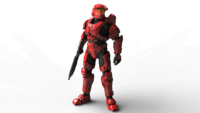
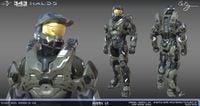
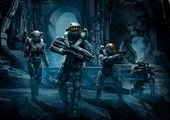






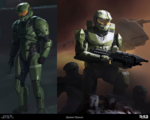
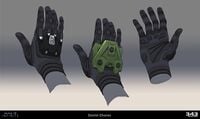

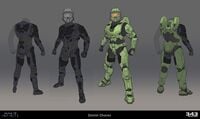
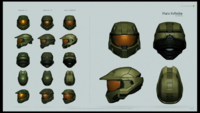
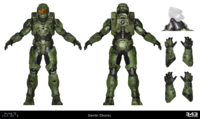
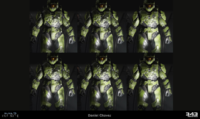



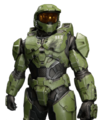
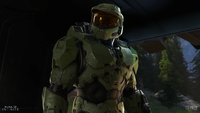

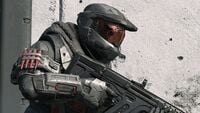
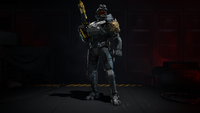
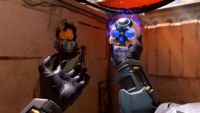
![A Spartan-IV wearing a Prototype Mark VI helmet and UA/Mark VI [GEN1] shoulders.](https://halo.wiki.gallery/images/thumb/f/f1/HINF-GEN1MarkVI.png/200px-HINF-GEN1MarkVI.png)
